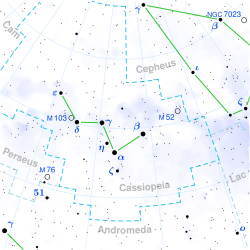Alpha Cassiopeiae
| Observation data Epoch J2000 Equinox J2000 |
|
|---|---|
| Constellation | Cassiopeia |
| Right ascension | 00h 40m 30.4405s |
| Declination | +56° 32′ 14.392″ |
| Apparent magnitude (V) | 2.240 |
| Characteristics | |
| Spectral type | K0IIIa |
| U−B color index | 1.14 |
| B−V color index | 1.16 |
| Variable type | Suspected |
| Astrometry | |
| Radial velocity (Rv) | −4.31 km/s |
| Proper motion (μ) |
RA: 50.36 mas/yr Dec.: −32.17 mas/yr |
| Parallax (π) | 14.29 ± 0.15mas |
| Distance | 228 ± 2 ly (70.0 ± 0.7 pc) |
| Absolute magnitude (MV) | −1.985 |
| Details | |
| Mass | 4–5 M☉ |
| Radius | 42.1 ± 1.7 R☉ |
| Luminosity | 676 L☉ |
| Temperature | 4,530 K |
| Metallicity [Fe/H] | –0.1 dex |
| Rotational velocity (v sin i) | 21 km/s |
| Age | 1–2×108 years |
| Other designations | |
| Database references | |
| SIMBAD | data |
Coordinates: ![]() 00h 40m 30.5s, +56° 32′ 14.5″
00h 40m 30.5s, +56° 32′ 14.5″
Alpha Cassiopeiae (α Cassiopeiae, abbreviated Alpha Cas, α Cas), also named Schedar, is a second magnitude star in the constellation of Cassiopeia. Though listed as the "alpha star" by Johann Bayer, α Cas's visual brightness closely rivals the 'beta' (β) star in the constellation (Beta Cassiopeiae, also named Caph) and it may appear marginally brighter or dimmer, depending on which passband is used. However, recent calculations from NASA's WISE telescope confirm that α Cas is the brightest in Cassiopeia, with a apparent magnitude of 2.240. Its absolute magnitude is 18 times greater than β Cas, although it is located farther away from the Sun (228 light years versus 54).
α Cassiopeiae (Latinised to Alpha Cassiopeiae) is the star's Bayer designation.
...
Wikipedia

